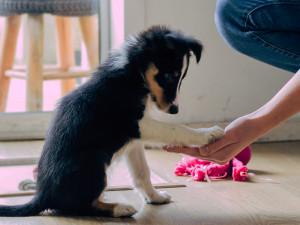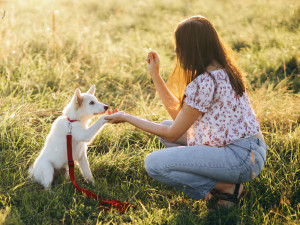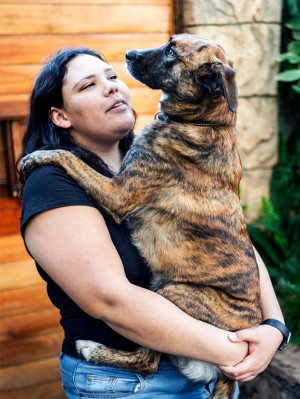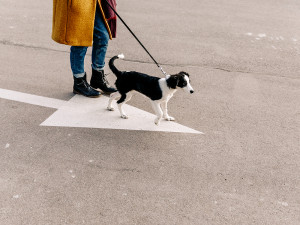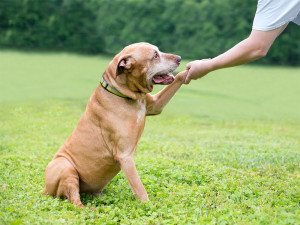Is Your Dog Scared of Stairs? Here’s How to Help Them Get Over It
With a little patience, some training, and a few treats, your pup will be scaling those steps in no time.
For even the most health-conscious human willing to bypass an elevator to get their steps in, stairs are an annoying but innocuous fact of life. But for some dogs, a flight of stairs might as well be Mount Everest. They come, they stare, and they do not conquer. This can become very frustrating for those of us who live, say, on the fourth floor of an apartment building that doesn’t even offer the option of an elevator. What’s a pet parent to do when that Great Dane puppy grows into a 150-pound statue who refuses to leave the ground floor?
Whether you’re training a new puppyopens in new tab or helping a reluctant adult dog overcome their fear, the right techniques will have your dog scaling those steps in no time. As with most training, the key is to be patient, methodical, and keep plenty of treats on-hand. Who wouldn’t learn to love the stairs if there’s a free snack at the top? Here, some training tips from two certified experts to help your dog master the ultimate vertical trial.
Why are some dogs afraid of stairs?
Fear of stairs is not overly common in adult dogs who’ve lived inside homes before, says Laurie Lawless, certified dog behavior consultant and owner of Shelter Behavior Integrationsopens in new tab. Most often, she says, “I see it when dogs just have not been overly socialized, have not lived inside previously, or are just sensitive and fearful to a new environment.”
Sometimes, dogs’ anxiety might stem from the kinds of stairs you have in your home. Older houses, in particular, tend to have narrow or steep staircases, which can create stress or vision challenges. If the floor texture on your stairs differs from the rest of your home, that can factor in as well; some harder floors can leave dogs feeling unstable, which is less than ideal when they’re trying to climb.
How much do you spend on your pet per year?
Floating stairs, which have gaps in between each step, can also scare dogs off, says Claren Mulhall, co-owner and head trainer at Cloud K-9 Dog Trainingopens in new tab. From a dog’s angle, she points out, those sleek, modern steps will look like they’re full of holes. If your dog is cowering at the top or bottom, try throwing a blanket over them so that they appear solid.
“Another consideration, and always my first consideration if I work with a dog who is afraid of stairs, is to rule out any medical causes,” Mulhall says. “A dog with knee or hip issues may be very uncomfortable or find it painful to use stairs, so they avoid them as much as possible.”
If your dog seems vehemently opposed to stairs, it’s worth checking with their veterinarian to make sure that their resistance is not a sign of bigger issues. The last thing you want is to make the condition worse by forcing them to push through it.
How can we help adult dogs who are afraid of stairs overcome their fears?
Just like most people wouldn’t love to learn how to swim by being thrown into a freezing cold swimming pool, it’s important to be gradual and deliberate when training your dog to deal with stairs. Both Lawless and Mulhall emphasize the importance of starting small. (Think: starting with just one stair.) For many dogs, Mulhall adds, it might be easier to try going down the stairs first, rather than up.
“Sit on the stairs with some yummy treats and encourage the dog to put a single paw on the step, then treat, then two paws and treat, etc.,” Mulhall says. “Don’t pull the dog up or down the stairs. Reward them with treats along the way.”
Lawless recommends throwing a treat away from the stairs after completing that same process. That little extra step can turn the exercise into a fun cat-and-mouse game while also creating an opportunity to seek consent from your dog to continue the training.
“If you go back towards the first step and the dog doesn’t follow you, that’s a sign, to me, that the dog was a little overwhelmed, versus a dog who is like, ‘Oh, I’ll jump back on those stairs for another cookie,’” Lawless says.
If you don’t have stairs in your home but want to teach your dog how to handle them in other environments, you can use obstacles like blocks, large books, exercise platforms, and even your legs to get them used to the movement of picking up all their legs. Claren says that wherever you’re training, the most important thing you can do is to make sure that whatever your dog does at the end of the stairs is going to be a good time — a play session or some treats, perhaps. In other words, save the veterinarian’s front steps for another time.
How can we help puppies become comfortable around stairs?
Puppies tend to be better at adjusting to new people, places, and things than older dogs, so if you have the chance to introduce your puppy to stairs, be sure to take advantage. If your puppy is still working on coordination and balance, Lawless recommends covering the stairs with something like a bath mat, a yoga mat, or even a roll of stair carpeting. This will ensure they don’t lose their footing. As always, treats will be your best friend.
From there, Lawless recommends gently guiding your puppy up the first step or two, allowing them to take their time getting familiar with the surface. Don’t worry about the rest of the staircase just yet — wait until your puppy seems confident navigating that first step. And just like with adult dogs, let their interest be your guide. If your puppy seems reluctant to get back on, that’s probably a sign that it’s time to hit pause.
“What we don’t want to do is force them up or down,” Lawless says. “We can definitely [overwhelm] them and then make them more fearful of the stairs. So it’s really important to not rush it.”
Too often, Mulhall agrees, pet parents can try too much too soon. Her suggestion? “Work with what your dog can handle. Don’t try practicing with stairs when you’re in a hurry.” With young puppies especially, be mindful of their physical development to avoid overdoing things.
How can I tell if training is overwhelming my dog?
It’s helpful to get to know all of the usual body language dogs use to convey stress, like stiff posture, darting eyes, and excessive lip-licking. That said, there are a few specific behaviors that you might want to watch for while working with stairs.
First, watch how your dog distributes their weight at the foot of the stairs. If they’re taking a step up but keep their back legs weighed to avoid putting too much weight on the step, it means that they’re not comfortable enough yet to ascend to the next step.
Stress panting is another sign to watch for. “Especially if they pant and look away from the stairs or look up at you, it means that they’re probably struggling with making that next step in a confident way,” Lawless says. “At that point, I would probably practice just teaching them to go up and down that first one or two sets of stairs with lots of treats, and doing that in very short sessions.”
If your home has stairs, Lawless recommends carrying your puppy up and down as needed, while they’re still in training. Don’t force your puppy to “sink or swim” by taking them all at once. The same goes for adult dogs. Avoid getting impatient and instead, focus on positively reinforcing the progress they’re making while taking things slow. If you have an extra-large dog who can’t be alone, consider sleeping downstairs with them overnight for a while as they build their skills.
“This is a lifelong commitment,” Lawless says, “and it’s best to set yourself up for long-term success, versus forcing an issue — because that might end up putting you backwards.”
When is it time to seek professional help?
It may be helpful to involve expert from the beginning. In addition to checking with your vet to rule out medical problems, Mulhall recommends seeking out a certified Fear Free trainer to help navigate the training process. Lawless, meanwhile, notes that for those who live on higher floors in apartment buildings with stairs, a professional can expedite the training progress and help your dog make faster progress than you might achieve on your own.
Wherever you are in your training journey, never fear. This kind of work takes time, and at times, it might feel like an uphill battle. But as the great Miley Cyrus once said, it ain’t about how fast [your dog] gets there, ain’t about what’s waiting on the other side — it’s the climb.


